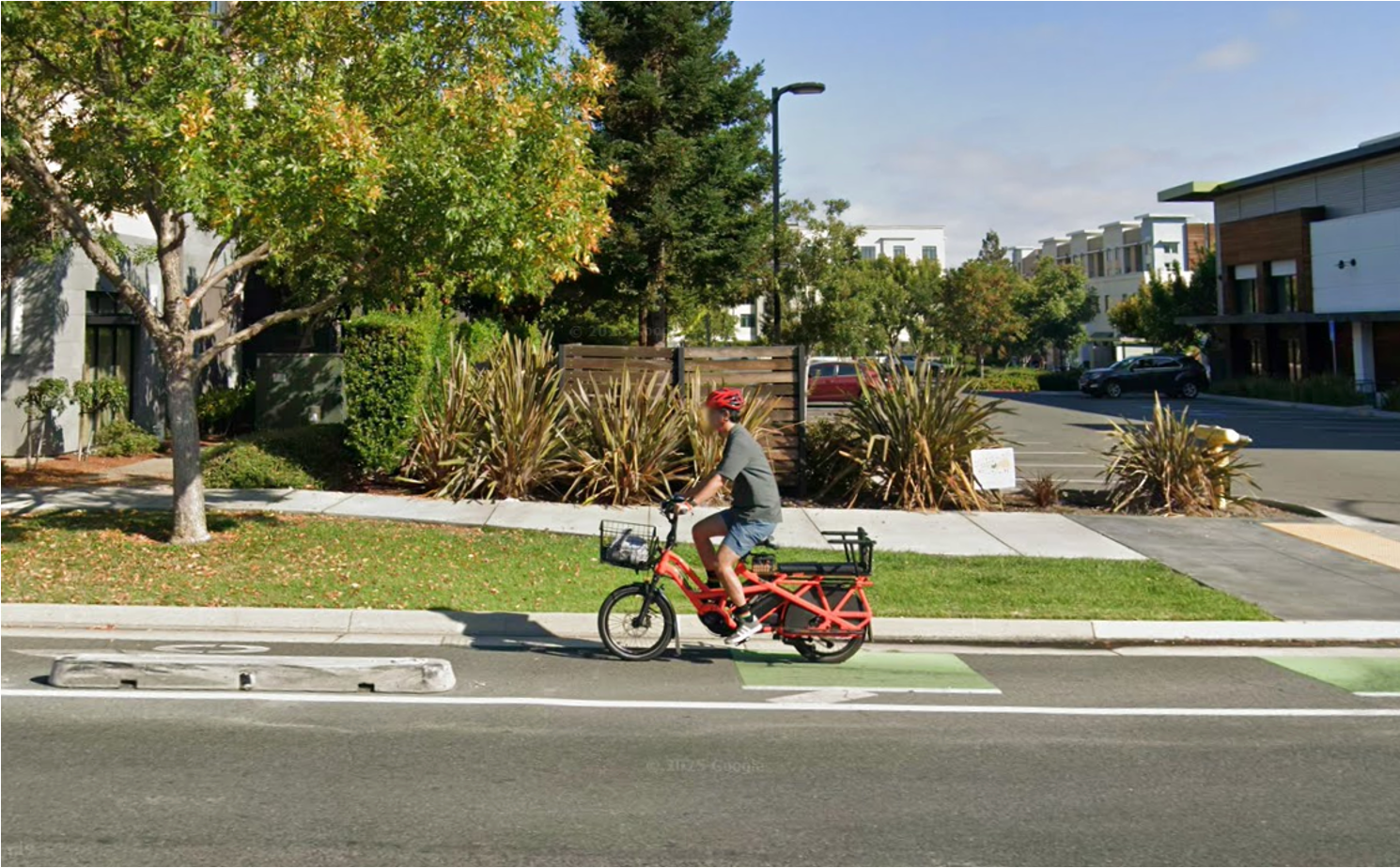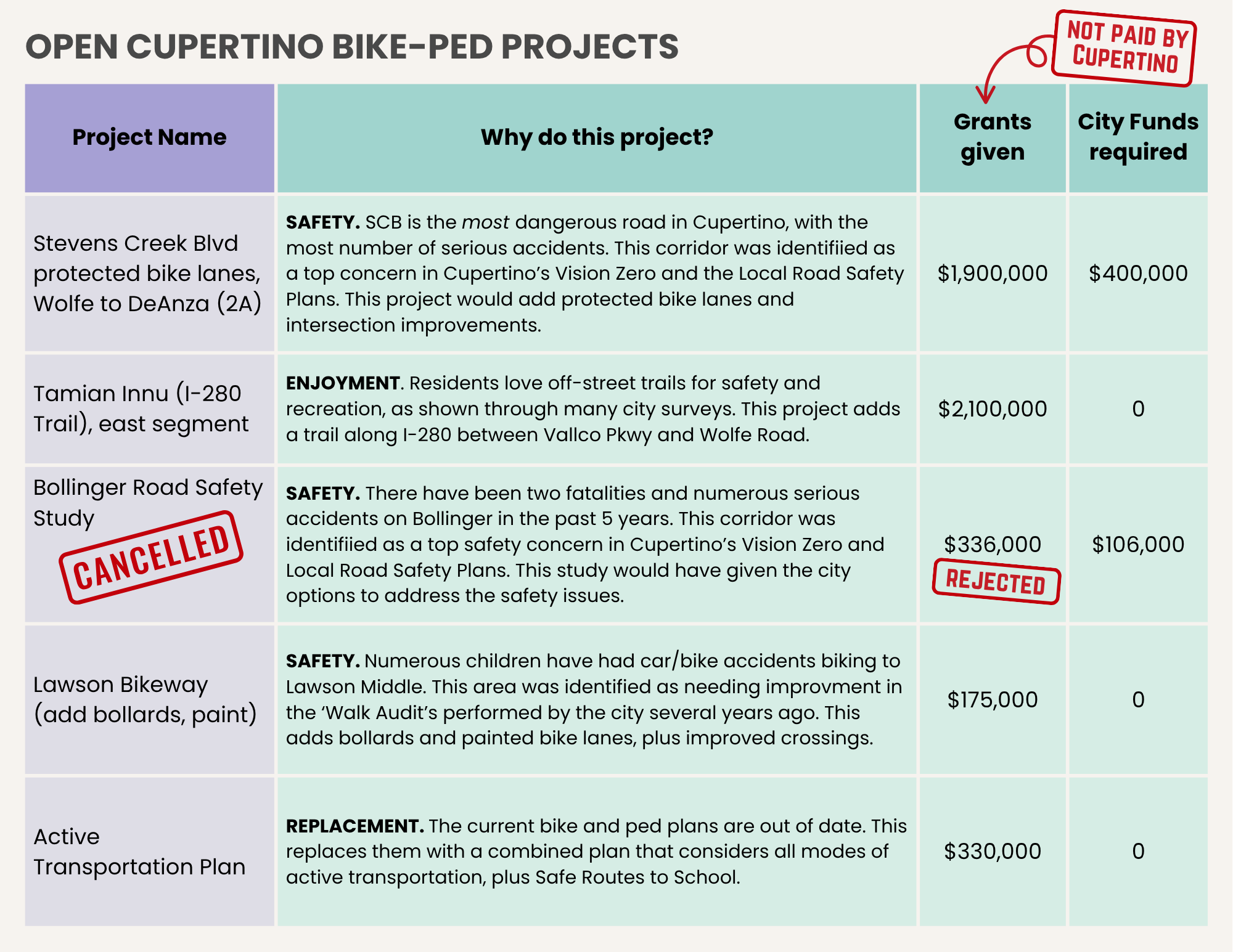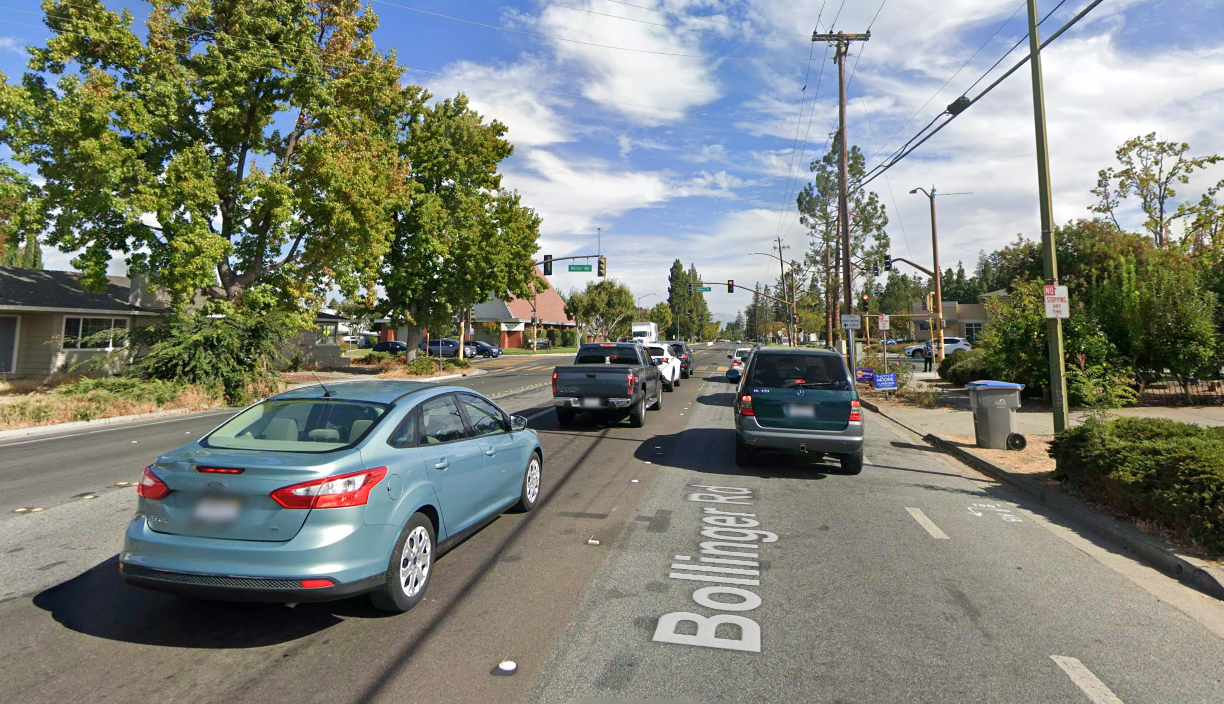
Every year, the Cupertino City Council prioritizes Capital Improvement Projects (CIP) to city land, parks, buildings, and infrastructure for funding. On May 20, 2025, three council members called for defunding important bike ped safety projects despite substantial data of fatalities and serious injuries.
- Mayor Liang Chao and Councilmember Ray Wang called to defund the Stevens Creek Boulevard Protected Bike Lanes Project
- Vice Mayor Kitty Moore and Councilmember Ray Wang called to defund the Bollinger Road Corridor Study.
These three councilmembers were successful in defunding the Bollinger Road Study, with Councilmember Mohan voting no and Councilmember Fruen recused. The Stevens Creek Boulevard Protected Bike Lanes Project survived as Mayor Chao and Councilmember Wang were unable to get 3 votes, with Councilmembers Moore, Fruen, and Mohan expressing their support for the project.
Need a refresher on the two projects? Click here to read the quick summaries at the end of this post.

With 90% of the cost of these bike ped projects being covered by grants, they have very little impact on the city’s budget. By defunding the projects, the city is actually turning down grants, making it difficult to win future grants, and having a negative impact on future city budgets as well.
Residents who walk or bike in Cupertino face significant safety issues – especially students, young families, and seniors – with serious injuries and fatalities occurring throughout the city with heartbreaking regularity.
Defunding these projects makes it clear that this council majority cares neither about the safety of our most vulnerable residents nor about the city’s financial health.
There appears to be a new political focus on making our roads primarily suited for cars and a new willingness to say out loud that the safety of pedestrians and cyclists is not a priority. The loudest voices on this new position are Mayor Liang Chao, Councilmember Ray Wang, and Planning Commission Chair Santosh Rao who have vocally expressed this on multiple occasions.
In the February 4 City Council meeting, Councilmember Ray Wang compared the 15 deaths and severe injuries of people on Stevens Creek near the De Anza Blvd intersection to the thousands of cars that make right-hand turns, indicating that this was an acceptable number of deaths and serious injuries to him to enable car drivers to save a few seconds of driving time at that intersection.

Killing the Bollinger Road Study
This viewpoint was at the forefront of defunding the Bollinger Rd Study with the council majority stating their desire to kill the study to prevent any safety improvements being made which could slow down or inconvenience car drivers.
The study – which does not make any road changes – was intended to investigate how the city might address the safety issues on Bollinger Road which have led to two fatalities and many serious injuries. The road was identified as a top project in the Vision Zero Plan, and has significant student traffic from Hyde Middle, Lynbrook High and Eaton Elementary schools. This was a joint study with San Jose as they are responsible for the south side of the road. The study was 75% funded through federal grants, with Cupertino only paying $106K.
It was clear immediately from the onset of the discussion that Mayor Chao, Councilmember Wang, and Vice Mayor Moore had already decided in advance to defund the study. Liang Chao expressed reluctance to lose the grant funding but that wasn’t enough to sway her into supporting the project.
Liang Chao and Ray Wang stated that the city has historically given too much importance to the safety of cyclists and as a result, they want to cancel ALL cyclist safety projects in the city, especially those that affect intersections.
Kitty Moore also voted to kill the Bollinger Rd Study but said she did it because “I did hope that we would have a comprehensive traffic study done for the city [instead]“. Cupertino’s traffic and streets have been studied extensively over the past 10 years, with significant traffic data already available in the 2024 Vision Zero Plan, the 2023 Local Road Safety Plan, the 2016 Bike Plan, and the 2018 Pedestrian Plan. The safety issues on the Bollinger Rd Corridor are already well documented. Vice Mayor Moore’s argument just doesn’t hold water and seems designed to kill the project without admitting to the intent to kill it.
Councilmember Ray Wang made several statements that are not backed up by any evidence and continues to be open about his opposition to any projects meant to improve the safety of pedestrians and cyclists. He made a speech about the rights of drivers and the city’s misguided emphasis on cyclist safety. It’s well worth a listen. He claimed that driver’s rights was a major plank in his and Kitty Moore’s city council campaigns (“we were mostly elected because of this issue”, timestamp 1:155:14) and that their election is a mandate to push for driver’s rights – a surprising assertion as the rights of drivers were never mentioned in any of their campaign messaging, literature, or debate statements. He also claimed to be a cyclist though no one has ever seen him on a bike in all the years he’s lived in the city and he’s never participated in any bike-related events.
The votes were as expected: 3-1 to defund the Bollinger Rd Study with Liang Chao, Ray Wang, and Kitty Moore voting to defund, and Sheila Mohan voting to keep the study (J.R. Fruen recused).
Second Attempt to Stop the Stevens Creek Bike Lanes
Evidently unhappy with the close vote on February 4 that kept the Stevens Creek bike lanes in the city’s CIP plan, Councilmember Wang again proposed defunding them in the May 20 meeting.
A councilmember bringing back a topic for a second vote because they are unhappy about the outcome of the first vote sets a very bad precedent. It erodes the public’s trust in council votes and makes city governance much more difficult. Council votes cannot be subject to constant re-litigation or they will become meaningless.
This time, however, Ray Wang went further and proposed a motion to defund ALL SCB protected bike lane projects – even the future phases that are not yet funded.
Mayor Liang Chao expressed support for killing the SCB protected bike lanes, though she expressed regret over losing the grant funding. No one seconded Ray Wang’s motion so it failed and the project will proceed.
Vice Mayor Moore was supportive of the SCB protected bike lanes project. She commented that the project has been in the works for years and multiple councils have voted in its favor. She also mentioned that it is a top project in the Vision Zero Plan and she affirmed that it’s the city’s policy to follow the Vision Zero Plan. We applaud Kitty’s stand on this and her willingness to support this important bike safety project.
Some key points in the council discussion are linked below. They are interesting to watch!
- Ray Wang makes a speech against the rights of cyclists: “drivers don’t have any say in the city”
- JR Fruen “I would see [ending] this project…as fundamentally at odds with Vision Zero and the concept of reducing deaths.”
- Kitty Moore “I am in favor of this project as it is in keeping with many years of decision making and policy by our city.”
- Ray Wang calls on all car-only advocates to rise up to assert their rights against considering cyclists: “support this.”
Conclusion
Elections have consequences, and unfortunately, we now have some council members who are not afraid to say out loud that they care more about the rights of car drivers to not be inconvenienced than about keeping cyclists – many of whom are students – safe from serious injuries and death.
We are pleased that the installation of protected bike lanes on SCB from Wolfe to De Anza will proceed. We will continue to push for Bollinger Rd safety improvements and keep you informed on opportunities to express your support.
